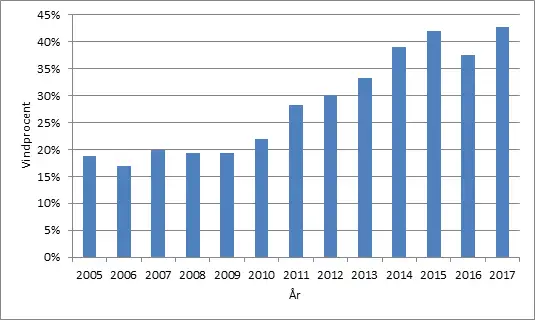The past nine out of ten years have been record-setting for Danish wind power. In 2017, Danish land and sea wind turbines produced the equivalent of 43.4 percent of total Danish electricity consumption. The new record surpasses the previous 2015 record of 42 percent. The news was welcomed by the Danish Minister of Energy, Utilities and Climate Lars Chr. Lilleholt (V), who commented:
"With the wind power production record, Denmark places a green flag on the world map. We once again show the whole world that Denmark has the world's best energy system. We have managed to accommodate large amounts of wind power and other green sources of energy, while maintaining high security of supply. In this way, there is always power when we plug a device into the plug.
More wind turbines - higher records
In the coming years, higher records will continuously be set by Denmark as new offshore wind farms are developed. This applies to Horns Rev 3 next to Esbjerg, Kriegers Flak in the Baltic Sea, North Sea South by Ringkøbing, and North Sea North by Harboøre. The additional wind farms will contribute to further increases in Danish wind production.
“The government is working for Denmark to have at least 50 per cent of its energy needs covered by renewable energy, such as wind and solar power, by 2030. This is a very ambitious goal, which can also lead to further jobs in the green sector - not least in the wind industry,” states Lars Chr. Lilleholt (V).
Denmark leads European electricity market
Denmark is part of the major European electricity market, with strong electricity connections to neighboring countries. Power is constantly flowing in and out of the country. This allows Danish producers to sell wind power abroad, while guaranteeing a plentiful supply at home. Additionally, Denmark can purchase electricity from other countries that have a surplus of electricity. This process ensures some of the world's lowest electricity prices. In this way, wind and the weather can be leveraged. In the long term, wind and solar energy storage will also play a major role. Wind and solar energy can be converted into hydrogen or other gases and then stored for further use (in batteries for example). In addition to energy production, wind and solar energy storage will contribute to ensuring security of supply on cloudy and less windy days.

Graph: The wind energy share of Denmark's electric energy system has grown significantly in recent years. 2017 set a new record of 43.4 percent. The decline shown in the graph in 2016 reflects low wind conditions.
Facts
When discussing the share of wind power, the share does not refer to what actually comes from the Danish electrical outlets. Since electricity is always purchased and sold once limits are exceeded, some of the Danish power (including wind-generated energy), ends up in the power outlets of Norwegians, Swedes and Germans. At the same time, Norwegian hydropower, German solar power and Swedish nuclear power ends up in Danish electrical outlets. Additionally, Denmark also imports wind energy.
Contact:
Head of Press relations: Jesper Caruso, jesca@efkm.dk / 4172 9184.